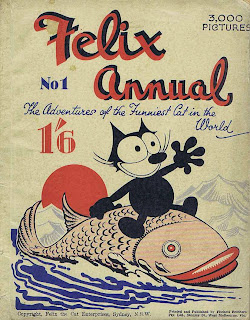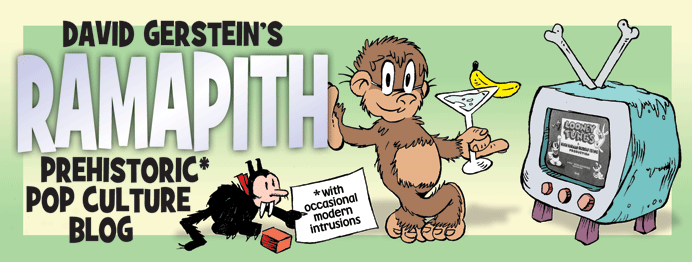 From kat to cat: it's time to bring one of my all-time favorite cartoon stars to this blog. Otto Messmer's Felix the Cat was one of the first animated characters who really acted—emoting to the audience, nodding and winking and turning viewers into co-conspirators. Who didn't want to go on an adventure with this wonderful cat? And those adventures... ranging from wacky comedy to truly far-flung fantasy. I've been a classic Felix buff since childhood—and the Silver Age Felix of Joe Oriolo, replete with funny bad guys and Jim Tyer animation, deserves his bon mots, too. Apart from these screen incarnations, Felix had just as rich a life in the comics, with Messmer, Oriolo, and Tyer once again contributing most of the great moments.
From kat to cat: it's time to bring one of my all-time favorite cartoon stars to this blog. Otto Messmer's Felix the Cat was one of the first animated characters who really acted—emoting to the audience, nodding and winking and turning viewers into co-conspirators. Who didn't want to go on an adventure with this wonderful cat? And those adventures... ranging from wacky comedy to truly far-flung fantasy. I've been a classic Felix buff since childhood—and the Silver Age Felix of Joe Oriolo, replete with funny bad guys and Jim Tyer animation, deserves his bon mots, too. Apart from these screen incarnations, Felix had just as rich a life in the comics, with Messmer, Oriolo, and Tyer once again contributing most of the great moments. But there was another Felix besides those we know so well. From 1927 to 1931, Felix's then-new daily strip featured stories drawn largely from recent cartoons—in adaptations so close you'd think actual animation drawings were used. And they were! Early Messmer assistant Jack Bogle was called upon to create these continuities, and his process evidently involved choosing the "best" frames from each scene, then reinking them and adding comics details such as dialogue and extra shading. But the stories, though near to their inspiration, weren't exact. Their dialogue, dense where Messmer's was sparse, painted Felix as a kind of smart-alecky hick—an interpretation that appeared nowhere else. No Felix but Bogle's babbled "The Night Before Christmas" every time he got knocked unconscious. And no Felix but Bogle's had a canine sports coach pal named Julius, who featured in several Bogle continuities that weren't adapted from films.
But there was another Felix besides those we know so well. From 1927 to 1931, Felix's then-new daily strip featured stories drawn largely from recent cartoons—in adaptations so close you'd think actual animation drawings were used. And they were! Early Messmer assistant Jack Bogle was called upon to create these continuities, and his process evidently involved choosing the "best" frames from each scene, then reinking them and adding comics details such as dialogue and extra shading. But the stories, though near to their inspiration, weren't exact. Their dialogue, dense where Messmer's was sparse, painted Felix as a kind of smart-alecky hick—an interpretation that appeared nowhere else. No Felix but Bogle's babbled "The Night Before Christmas" every time he got knocked unconscious. And no Felix but Bogle's had a canine sports coach pal named Julius, who featured in several Bogle continuities that weren't adapted from films.Very few of Bogle's continuities have ever been anthologized in the United States. But curiously enough, Australia's Adventures of Felix comic book couldn't get enough of them in the late 1930s and early 1940s. That comic book's annual extras provided the striking covers I'm displaying here today, and that comic also offered the complete Bogle continuity seen below, an adaptation of The Oily Bird (1928) that originally ran from October 24 to November 3, 1928.
"Luke McCluck, a barnyard chicken, enters the house for no good reason..."





Nothing more to see here—keep on walking! (To the official Felix website, where their Oriolo "Comic Strip of the Day" features vintage 1950s strips... with Felix as almost a feline Dagwood.)



















